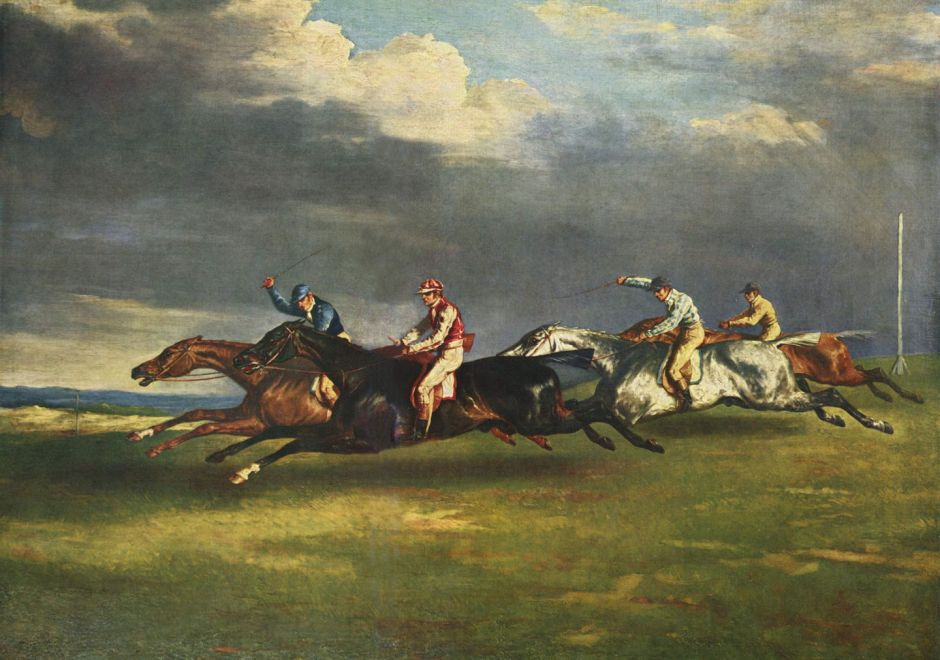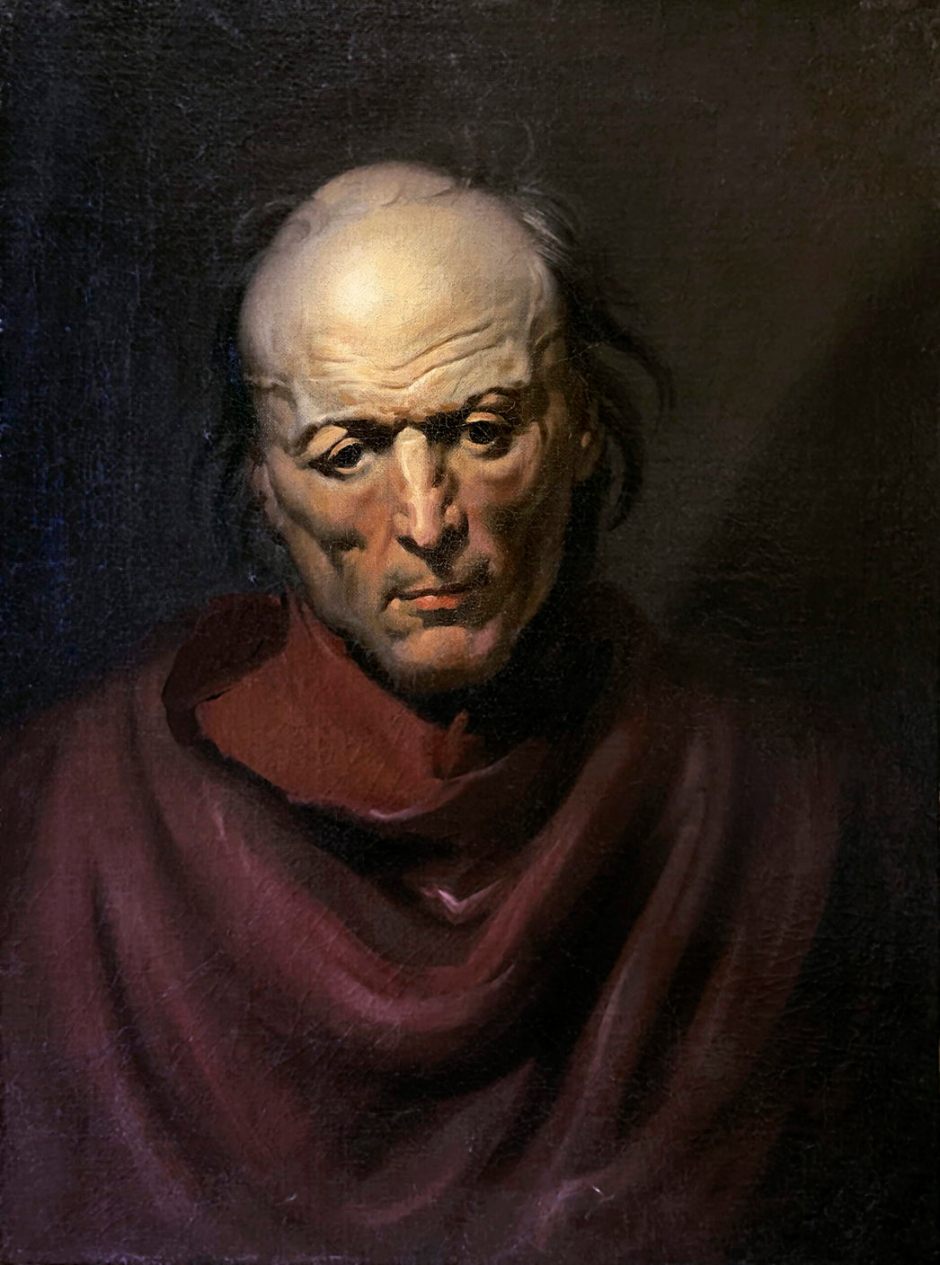Following the mixed reception of his masterwork The Raft of the Medusa, Théodore Géricault was hunting ideas for a successor. In 1821, having recovered from his illness, he returned to London, where he stayed with a horse dealer and took delight in painting horses again.

The Epsom Derby from 1821 follows the convention of the day in showing galloping racehorses flying through the air without contact with the ground beneath them. It wasn’t until early photographic studies demonstrated that this never occurred in real life that artists reluctantly changed their images.
The Derby Stakes is a flat-race that has been run on Epsom Downs, to the south of London, since 1780. At this time it was run on a Thursday in late May or early June, despite the unseasonal weather seen here. It was accompanied by a large fair, the subject of a later painting by William Powell Frith in 1858. I suspect that Géricault’s version was a significant influence on the equestrian paintings of Edgar Degas.
Géricault also developed an interest in Lord Byron’s poem Mazeppa, which had only been published in 1819 and was immediately translated into French. Much of this poem details the suffering and endurance of a future leader of Ukraine during a long journey tied naked on the back of a horse, as punishment for his affair with a Polish Countess.

He was among the first artists to paint Mazeppa, here in his first study from about 1820. The wild horse has just swum across a river at night, and is now climbing up the bank. The viewer is almost guaranteed to wince in sympathy with the Cossack’s cold and pain.

In what must have been one of his last paintings, Géricault revisited Mazeppa in 1823, the year before his death.
In 1822, Géricault’s health continued to decline. He suffered three serious riding accidents, and a growth was found at the base of his spine. Later in that year he improved sufficiently to make some lithographs, and compile a series of ten portraits of people suffering from mental illness, then described as monomanias. He was introduced to these patients by one of the early practitioners of psychiatry, his friend Doctor Étienne-Jean Georget (1795-1828), who commissioned him to paint them to show to students as examples. Georget was the first psychiatrist to propose that insanity should be a defence to criminal charges.
At the time, the pseudoscience of physiognomy remained popular, even among medical professionals. It claims that you can assess personality or character from a person’s outward appearance, particularly their face. Phrenology took this a step further in claiming that mental traits can be predicted from the form of a person’s skull, particularly bumps on different parts of the cranial vault.
In 1772, Johann Lavater codified what was at heart a pseudoscientific basis for racism and other forms of prejudice. Unfortunately, his writings were widely translated, and were enthusiastically adopted by many artists. Among more recent artists who used physiognomy in their painting are Joshua Reynolds, Henry Fuseli, William Blake and William Powell Frith. It wasn’t until the late nineteenth century that physiognomy and phrenology went into decline, and even then Sir Francis Galton tried to classify people according to their appearance, using composite photography.

Although intended as finished portraits, The Monomaniac of Envy (The Hyena), from about 1821-23, is surprisingly painterly beyond the woman’s face.

The Monomaniac of Gambling (c 1821-23) shows an older man holding a crutch.

While the face of The Monomaniac of Melancholy (c 1821-23) is well-studied, it’s hard to see how any of these cast any light on the states of their mind, or mental illness.
Several of the paintings in this series have apparently been lost. The last shown here, believed to be the sixth, was only rediscovered recently, between 2013-19 in Ravenna, Italy.
In 1823, Géricault lost his investments as a result of bad speculation on the stock market on the part of his advisor. By October he was confined to bed, and his friends could see death approaching. Despite that, he continued to plan major history paintings, including one on the slave trade, and another on the Inquisition.
On 26 January 1824, Théodore Géricault died in Paris.

The young and promising history painter Ary Scheffer painted his tribute as The Death of Théodore Géricault (1824). At the artist’s bedside are his close friends Colonel Bro de Comères and the painter Pierre-Joseph Dedreux-Dorcy, and the wall of the room is covered by his paintings.
On 2-3 November 1824, at the posthumous sale of his paintings, the French State finally purchased The Raft of the Medusa, for the minimum price allowed.
Géricault’s impact on narrative painting and visual arts more generally has been great and sustained. Many of the nineteenth century paintings of more contemporary history, including those of the Greek War of Independence by Eugène Delacroix, show their debt to The Raft of the Medusa. He also demonstrated how a single painting can influence public opinion, in the way that Picasso’s Guernica did over a century later in 1937. The lasting tragedy is that those in power still haven’t got the painting’s underlying message, that decisions made for politics rather than good sense bring dire consequences.

